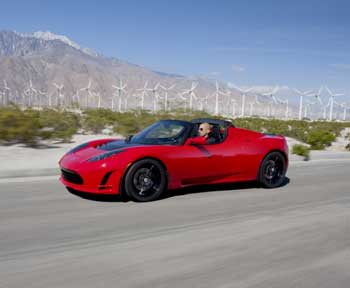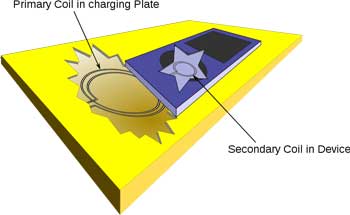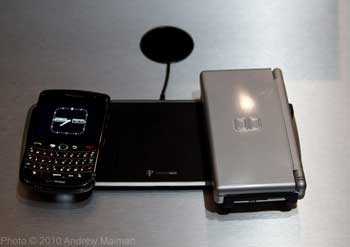Pulling the Plug on Conventional Charging

Tesla Roadster
Photo Courtesy of Tesla Motors

Inductive Charging
Image Courtesy of Egmason (Wikipedia)

Powermat
Photo courtesy of Andrew Maiman
Imagine walking into your bedroom and your cell phone starts charging immediately, you don't even have to bother plugging it in. Picture a truly wireless computer, one that charges without any cumbersome power chords. Now put yourself in the driver's seat of an all electric Tesla Roadster. As you soar down a freeway far from home, there's no sound except the wind rushing past the window, as the sports car recharges its batteries from the very road beneath its tires.
As you are reading this, all of these capabilities are being developed in scientists' labs around the country thanks to a technology known as inductive charging.
When electrons move through a conductor, it generates a surrounding magnetic field that flows with the electrons. If a second conductor is placed inside of the magnetic field then the magnetic force from the first conductor will pull the electrons in the second.
Induction was discovered soon after the phenomena of electromagnetism – nearly two hundred years ago – and the technology is already used in things as common as electric toothbrushes and generators. Induction has also become popular to charge cell phones wirelessly; with companies like Powermat offering a special cell phone battery attachment that allows a phone to charge when placed on top of a thin charging pad.
Those applications still require a connection between the battery and the charger, however engineers are now taking things a step further. Applying the same concept as the cell phone pad, engineers from the New Zealand based company HaloIPT have created a much larger pad capable of charging an electric car battery by simply parking overtop of the device.
Scientists at the Oak Ridge National Laboratory in Tennessee have also created a similar device that can charge an electric car wirelessly, but instead of a pad, the battery and charging device are connected via antennas that emit electromagnetic waves. The device transmits electricity with a 90 percent efficiency over a distance of one foot, which is about the same efficiency as simply plugging something into an outlet.
Some energy researchers believe that such wireless charging technology will eventually allow electricity to be transmitted for miles without power lines. And the most enthusiastic even speculate that the technology could one day be used to beam power back to Earth from massive solar panels orbiting out in space.
The potential applications are limitless and the wireless charging industry is expected to grow more than ten times larger in the next decade. Most likely, the growth will come from making ordinary consumer electronics less cumbersome by eliminating power chords; so you never have to unplug the coffee pot to use the toaster or search around for a free outlet. However, the potential for monumental leaps will come along with it as well.
The Oak Ridge scientists speculate that a continuous charging system could be set up to electrify American freeways. By embedding these sorts of devices directly into the roadway or along the center median, electric cars could charge as they drive. Long distance power generation could also be used to transmit electricity from distant wind farms or solar power arrays without the use of environmentally damaging power grids that require vast amounts of copper.
While the most farfetched of these ideas will require many years to develop, we can at least expect to trip on less power chords in our lifetimes.














